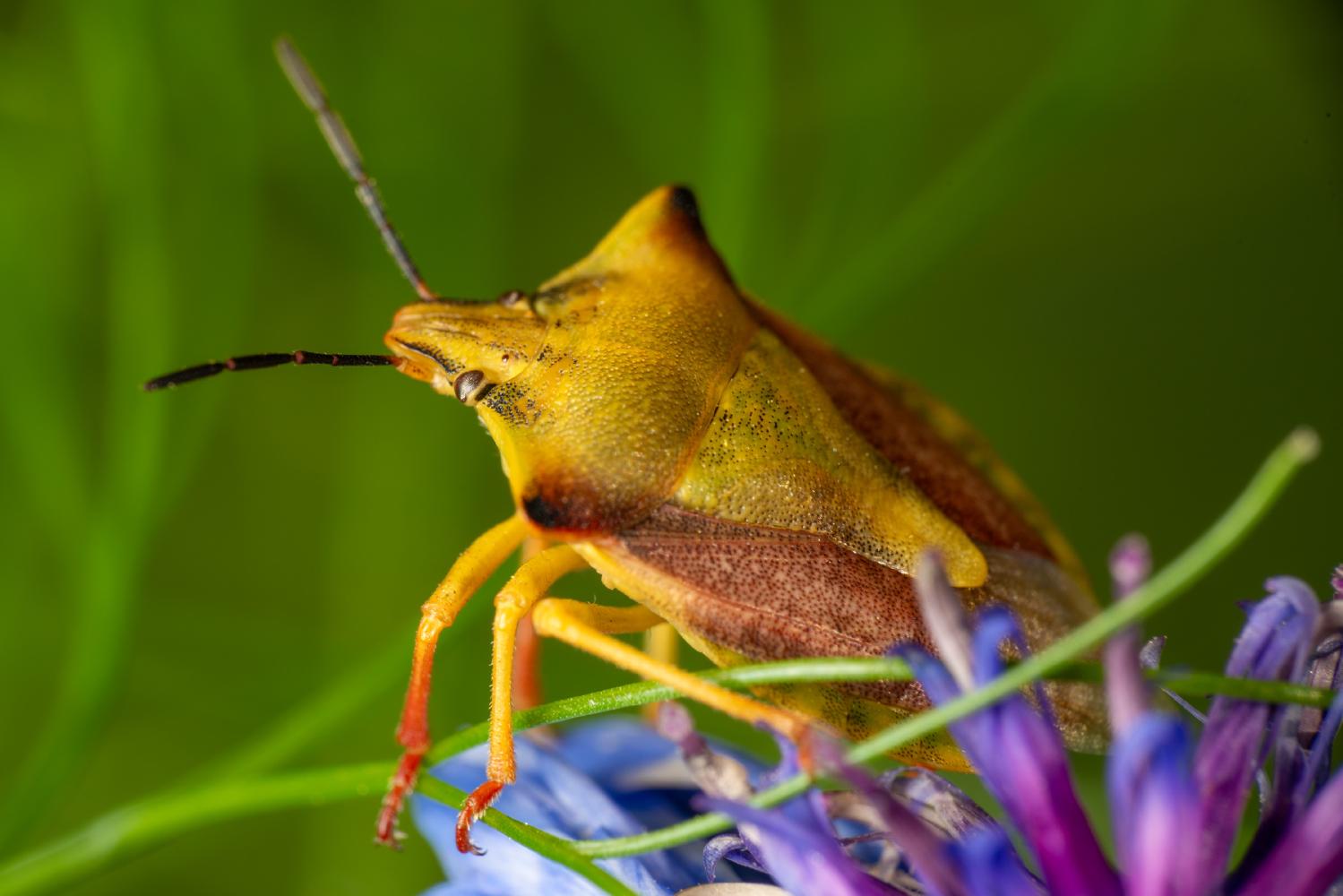Stink Bugs
Lat. “Pentatomidae“
family
of suborder
“True Bugs“
1 family, 22 species
Pentatomidae, commonly known as shield bugs or stink bugs, are named for their shield-like body shape and defensive ability to release a pungent spray. The name “Pentatomidae” comes from the Greek words meaning “five” and “section,” referring to the five segments of their antennae. There are several subfamilies within Pentatomidae, each with different genera. These bugs are considered agricultural pests as they can damage crops and are resistant to many pesticides. In some regions, stink bugs are eaten and used in culinary preparations. The brown marmorated stink bug is an invasive species that has spread throughout the United States.
Hierarchy
Etymology
The name “Pentatomidae” is from the Greek pente meaning “five” and tomos meaning “section”, and refers to the five segments of their antennae. Pentatomids are generally called “shield bugs” in British English, or “stink bugs” in American English. However, the term shield bugs is also applied broadly to include several related families (e.g. Acanthosomatidae, Scutelleridae, and Cydnidae), or specifically only to refer to species in the family Acanthosomatidae. The term shield bug refers to the generalized body shape of adult bugs in these families which resembles a heraldic shield when viewed from above. The American name “stink bug” is specific to the Pentatomidae, and refers to their ability to release a pungent defensive spray when threatened, disturbed, or crushed. The composition of this spray may vary between species, and even by sex or age, but generally includes aldehydes and alkanes. Descriptions of the smells vary widely, and include oily, dusty, woody and earthy, and like coriander. In some species, the liquid contains cyanide compounds and a rancid almond scent, used to protect themselves and discourage predators.The term “stink bug” may also be a vernacular for unrelated insects such as pinacate beetles (in the genus Eleodes).
Taxonomy
There are several subfamilies, of which the Aphylinae is often given family status, but is here retained as a subfamily, following Grazia et al. (2008). The subfamilies include: Aphylinae Bergroth, 1906 – AustraliaAphylus Bergroth, 1906 Neoaphylum Štys & Davidová-Vilímová, 2001Asopinae Spinola, 1850 Troilus Stål, 1868 Cyrtocorinae Distant, 1880Ceratozygum Horváth, 1916 Cyphothyrea Horváth, 1916 Cyrtocoris White, 1842 Pseudocyrtocoris Jensen-Haarup, 1926Discocephalinae Fieber, 1860 Discocephala Laporte, 1832 Ochlerus Spinola, 1837 Edessinae Fieber, 1860 Pentatominae Leach, 1815 Bathycoelia Amyot & Serville, 1843 Pentatoma Olivier, 1789 Phyllocephalinae Amyot & Serville, 1843 Cressona Dallas, 1851 Megarrhamphus Bergroth, 1891 Phyllocephala Laporte, 1833 Tetroda Amyot & Serville, 1843 Podopinae Amyot & Serville, 1843 Graphosoma Laporte de Castelnau, 1833 Podops Laporte de Castelnau, 1833 Serbaninae (monotypic)Serbana borneensis Distant, 1906Stirotarsinae (monotypic)Stirotarsus Bergroth, 1911incertae sedisAntillosciocoris Thomas, 2005 Asopus Burmeister, 1834 Jostenicoris Arnold, 2011
Description
All pentatomids have 5-segmented antennae, and 3 tarsal segments on each foot. They generally have a large triangular scutellum in the center of the back. The body shape of adult pentatomids is generally “shieldlike,” when viewed from above, but this varies between species, and is not true for the immature nymphal stages. The forewings of stink bugs are called hemelytra, with the basal half thickened while the apex is membranous. At rest, the wings are laid across the back of the insect, with the membranous wingtips overlapping. The hindwings are entirely membranous.
Economics
Several stink bugs and shield bugs are considered agricultural pests, because they can grow into large populations that feed on crops, damaging production, and they are resistant to many pesticides. They are a threat to cotton, corn, sorghum, soybeans, native and ornamental trees, shrubs, vines, weeds, and many cultivated crops.In Mexico, some species of stink bugs are called jumil, chinche de monte, xotlinilli, or chumil (e.g. Edessa mexicana). They are most often eaten in the states of Morelos and Guerrero. The flavor is sometimes said to resemble cinnamon, or sometimes a bitter medicinal flavor. Jumiles may be used for making sauces or as taco filling.Since recent arrival in the U.S., populations of the brown marmorated stink bug have grown significantly. As of October 2014, brown marmorated stink bugs can be found in 41 out of 50 states within the U.S. In 2016 New Zealand’s MPI put out an alert to prevent this invasive species from entering via imported cargo.
See also
List of Pentatomidae genera Chinavia hilaris, the green stink bug Alcaeorrhynchus grandis Cosmopepla lintneriana, the twice-stabbed stink bug Halyomorpha halys, the brown marmorated stink bug Oebalus pugnax, the rice stink bug Euthyrhynchus floridanus, the Florida predatory stink bug
European species
European species within this family include:
External links
When Twenty-Six Thousand Stinkbugs Invade Your Home by Kathryn Schulz. The New Yorker, March 12, 2018. Ed Yong called it a “pure delight.” I.A.D. Robertson: The Pentatomoidea (Hemiptera: Heteroptera) of Sub-Saharan Africa : a database. Malindi, 2009 Shieldbugs of Britain Stink Bugs of North America – photos and information Images of shield bugs I. A. D. Robertson: The Pentatomoidea (Hemiptera: Heteroptera) of Sub-Saharan Africa : a database. Malindi, 2009. Online version in Repository Naturalis Leiden
Ancestry Graph
Further Information
Copyright

This article uses material from the Wikipedia article Pentatomidae the free encyclopedia Wikipedia which is released under Creative Commons Attribution-ShareAlike 4.0 International License). On Wikipedia a list of authors is available.
